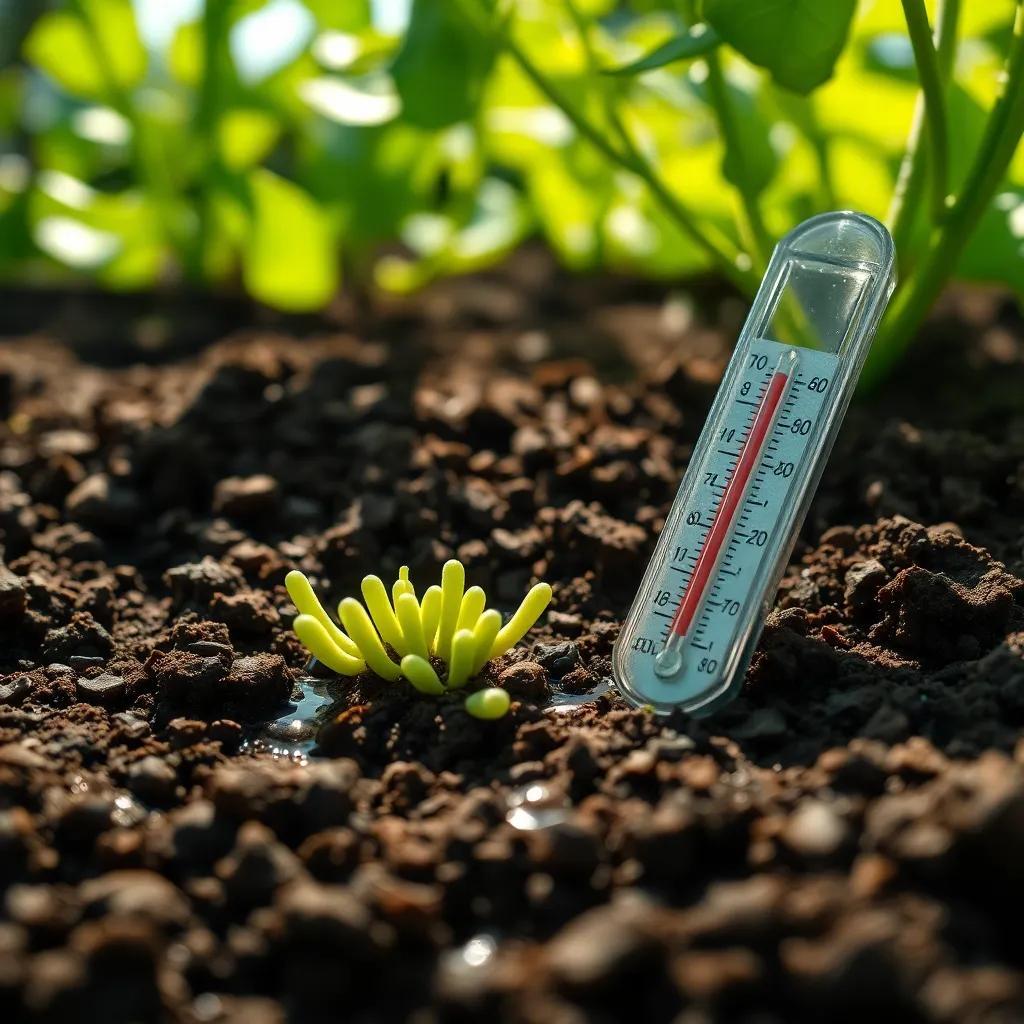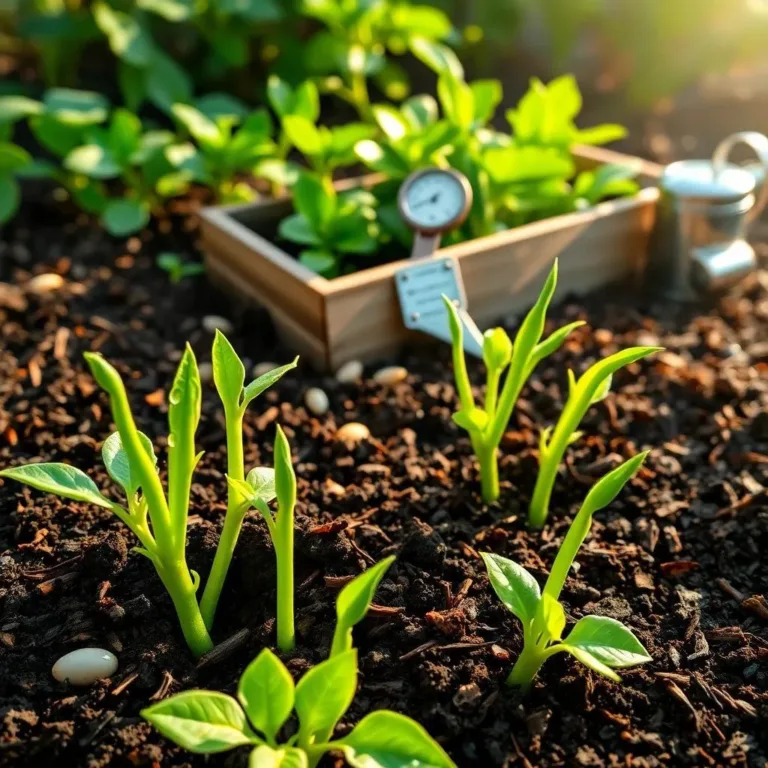Are you ready to watch those green beans sprout and grow? Planting green beans can be a fun and rewarding experience, but it all starts with knowing how to give them the best chance to thrive! From choosing the right seeds to understanding their germination needs, this guide will help you become a green bean-growing pro in no time! Let’s dig in!
Ideal Temperature Range for Green Bean Germination
When it comes to growing green beans, temperature is like the secret ingredient that can make all the difference! Green beans prefer warm soil, and getting that temperature just right can help your seeds sprout faster. Generally, they thrive best when the soil temperature is between 70-80°F (21-27°C). That’s like the cozy blanket of warmth beans love to soak up!
So, how do you know if your soil is warm enough? Well, I like to use a simple soil thermometer! It’s an easy way to check the temperature without second-guessing. If you discover that your soil is a bit chilly, don’t panic! Here are a few tricks to warm it up:
- Black plastic mulch: This can absorb sunlight and warm the soil underneath. Plus, it helps keep weeds at bay!
- Row covers: These are great for adding an extra layer of warmth. Just place them over your planting area to keep the heat in!
Now, while green beans love warmth, extreme temperatures can be a real party pooper! If it gets too hot, above 90°F (32°C), germination may slow down or even stop altogether. And trust me, nobody wants to wait even longer for their beans to sprout.
So, keep an eye on the weather, and don’t be afraid to adjust your planting schedule based on the forecast. If you find that it’s still too cool outside when you want to plant, starting your seeds indoors might just be the perfect solution! This way, you can give them a warm start before moving them outside when conditions are just right.
Understanding Soil Moisture Requirements
Now that we’ve got the temperature sorted out, let’s chat about moisture because, let’s face it, beans love a good drink! Moisture is super important for germination. Without it, those stubborn seeds might just sit there, looking pretty but not doing much else.
So, how much water do they need? Well, green bean seeds prefer soil that’s consistently moist but not soaking wet. Think of it like giving your beans just the right amount of water, kind of like how you’d want just the right amount of dressing on your salad!
Here are some tips to help you maintain that perfect moisture level:
- Water regularly: Check the soil every few days. If it feels dry a couple of inches down, it’s time to give it a drink!
- Don’t overwater: Too much water can lead to rotting seeds. Yikes! If your soil is waterlogged, your seeds might not make it.
- Mulch: Adding a layer of mulch can help keep the moisture in the soil while also regulating temperature. It’s like a little protective blanket for your plants!
And remember, if you ever feel unsure, just dig a little in the soil! If it’s crumbly and feels slightly damp, you’re on the right track. Trust me, with just the right moisture and temperature, you’ll be on your way to growing some fantastic green beans in no time! Happy planting!

Choosing Quality Seeds for Successful Germination
When it comes to growing green beans, the journey starts with the seeds! Choosing high-quality seeds is like selecting the best ingredients for your favorite recipe. It lays the foundation for a successful garden! So, how do you pick the right seeds? Let’s break it down!
- Freshness Matters: Always look for seeds that are labeled as fresh. Older seeds may have lower germination rates, which can be super frustrating. I always check the packaging date. If it’s more than a year old, I skip it.
- Source Selection: Buy seeds from reputable suppliers. Good stores and gardening centers know how to store seeds and keep them viable. Reading reviews or asking fellow gardeners can help identify where to shop!
- Check for Damage: Before buying, take a close look at the seeds. They should look plump and healthy, not shriveled or damaged. This is important because healthy seeds have a better chance of sprouting!
- Variety Choice: Different green bean varieties can have different growth times and flavors. Do a little research on your options! Some beans grow faster, while others may have unique tastes. Picking a variety you enjoy will make your meals extra special!
By focusing on seed quality from the start, you set yourself up for a bountiful harvest. With fresh and healthy seeds, you’ll watch those green beans grow strong and vibrant!
Best Practices for Planting Seed Depth
Now that we’ve got our quality seeds, it’s time to plant them! But here’s the thing—planting depth matters! It can affect germination, so let’s dig into the best practices for planting those precious seeds!
- Right Depth: Green bean seeds should be planted about 1 to 1.5 inches deep. This depth allows them to get enough moisture and warmth while making it easier for them to break through the soil. If you go deeper, the seeds might struggle. If you plant them too shallow, they can dry out or get eaten by pesky critters!
- Spacing is Key: When planting, remember to space your seeds about 2 to 4 inches apart. This gives each plant enough room to grow and flourish without overcrowding. Overcrowded seeds can lead to competition for nutrients and sunlight, which isn’t fair!
- Soil Preparation: Before planting, clear the area of any debris, like rocks or old roots. Mix in some organic matter, like compost, to make the soil rich and inviting. Beans love good dirt!
- Gentle Hands: After you plant the seeds, cover them gently with soil. You can lightly pat the surface to give them a cozy environment. No need to pack the soil too tightly; just enough to help them settle in.
By following these planting depth practices, you’ll create an ideal home for your seeds to germinate and thrive. Just think of it as tucking them into bed for a good night’s sleep before they wake up and grow into glorious green bean plants!
Factors That Influence Germination Time
Have you ever wondered why some green bean seeds pop up faster than others? Well, several factors influence germination time, and understanding them can help us get those beans sprouting in no time!
- Temperature: We already chatted about how green beans love warm soil, right? If the temperature is too cool (below 50°F or 10°C), germination can slow down. On the flip side, if it gets too hot, it can also stall the process. The sweet spot is between 70-80°F (21-27°C).
- Moisture Levels: The right amount of moisture is key! Remember, seeds need a drink, but not a flood! Too little moisture can delay germination, and too much can lead to rotting, which is no fun at all.
- Seed Quality: We talked about choosing good seeds earlier. Fresh, high-quality seeds sprout faster! If you sow old or damaged seeds, you might be waiting longer than expected.
- Soil Conditions: Well-draining, nutrient-rich soil is what green beans thrive in! If your soil is compacted or low in nutrients, it can slow down the sprouting process. Don’t forget to prep your soil properly before planting!
- Variety Type: Each green bean variety has its own timeline for germination. Some may sprout within 7-10 days, while others can take up to 14 days. If you’re growing multiple types, keep an eye on them for different sprouting times!
By understanding these factors, you’ll be better equipped to achieve healthy germination and delicious green beans in your garden. It’s all about giving those seeds the best chance to flourish! Happy gardening!

